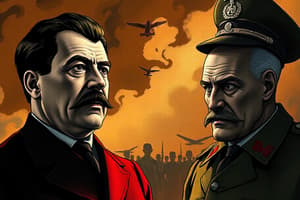Podcast
Questions and Answers
What prompted the rise of the Nazi Party in Germany?
What prompted the rise of the Nazi Party in Germany?
- The economic and psychological crisis faced by Germany after World War I (correct)
- The widespread support for socialist ideals
- The overwhelming desire for a return to a monarchy
- The belief that the Versailles Treaty was fair and just
Which of these actions did Hitler take after assuming power in Germany?
Which of these actions did Hitler take after assuming power in Germany?
- He sought to maintain a peaceful relationship with neighboring countries
- He dismantled the democratic Weimar government and established a dictatorship (correct)
- He strengthened the democratic institutions of the Weimar Republic
- He promoted a cultural revolution rejecting German nationalism
What is the main characteristic of totalitarianism that makes it attractive to desperate citizens?
What is the main characteristic of totalitarianism that makes it attractive to desperate citizens?
- The promise of individual freedom and liberty
- The promise of strong leadership and a sense of national unity (correct)
- The promotion of a diverse and inclusive society
- The emphasis on economic equality and social justice
What is an example of how a totalitarian regime suppressed opposition?
What is an example of how a totalitarian regime suppressed opposition?
What were the three key factors contributing to the rise of totalitarianism in Europe?
What were the three key factors contributing to the rise of totalitarianism in Europe?
Which of the following was a factor in the rise of Benito Mussolini to power in Italy?
Which of the following was a factor in the rise of Benito Mussolini to power in Italy?
What was the main goal of Joseph Stalin's "five-year plans"?
What was the main goal of Joseph Stalin's "five-year plans"?
What was a key characteristic of the Weimar Republic that contributed to its downfall?
What was a key characteristic of the Weimar Republic that contributed to its downfall?
How did the Versailles Treaty contribute to the rise of dictatorships in Europe?
How did the Versailles Treaty contribute to the rise of dictatorships in Europe?
Which of the following is NOT a characteristic of Fascism?
Which of the following is NOT a characteristic of Fascism?
What was the impact of Hideki Tojo's leadership on Japan?
What was the impact of Hideki Tojo's leadership on Japan?
What was the significance of the "purges" carried out by Joseph Stalin?
What was the significance of the "purges" carried out by Joseph Stalin?
What was the main difference between the rise of Mussolini in Italy and Stalin in the Soviet Union?
What was the main difference between the rise of Mussolini in Italy and Stalin in the Soviet Union?
Flashcards
Adolf Hitler
Adolf Hitler
Leader of the Nazi Party and Chancellor of Germany who established a dictatorship.
Nazism
Nazism
Ideology promoting racial purification and territorial expansion, founded by Hitler.
Third Reich
Third Reich
The totalitarian regime established by Hitler after dismantling democracy in Germany.
Totalitarianism
Totalitarianism
Signup and view all the flashcards
Francisco Franco
Francisco Franco
Signup and view all the flashcards
Weimar Republic
Weimar Republic
Signup and view all the flashcards
Radical Governments
Radical Governments
Signup and view all the flashcards
Benito Mussolini
Benito Mussolini
Signup and view all the flashcards
Fascism
Fascism
Signup and view all the flashcards
Joseph Stalin
Joseph Stalin
Signup and view all the flashcards
Collectives
Collectives
Signup and view all the flashcards
Hideki Tojo
Hideki Tojo
Signup and view all the flashcards
Militarism
Militarism
Signup and view all the flashcards
Study Notes
World War II - The Rise of Dictators
- Post-WWI era was different for the rest of the world than the US
- German Weimar Republic lost support due to resentment over war-guilt clause, demilitarization, and loss of territories
- Economic depression and struggles to recover incited revolutions and rise of radical governments in Russia and Italy
- New democracies failed due to lack of experience and support
- Desperation set in globally, with collapses of governments leaving leadership vacuums
- Economic collapse and the weaknesses of the Versailles Treaty combined to bring radical leaders with ambitious promises into power.
Dictatorship in Italy
- Benito Mussolini, a WWI veteran, headed the Italian Fascist Party in 1921
- Nicknamed "Il Duce," he used powerful speaking to gain nationalist support
- Fascism put the interests of the state above the individual
- Mussolini quickly gained support from Italy's upper and middle classes, the military, and prominent government officials
- By 1921, high unemployment, inflation, and fear of communism led to popular support
- In 1922, Mussolini and his Blackshirts marched on Rome and seized power in a bloodless coup
- Tight regulation of every part of life and crushing of opposition were part of his rule which promised a new Roman Empire.
Dictatorship in the Soviet Union
- Joseph Stalin became Soviet Premier in 1924 after Lenin's death
- He abolished private farms, reorganizing them into collectives
- His "purges" used secret police to eliminate his enemies (millions killed/missing).
Dictatorship in Germany
- Adolf Hitler headed the National Socialist German Workers' Party (Nazi)
- Nicknamed "Der Fuhrer," his powerful speaking inspired Germans in economic/psychological crisis.
- Hitler wrote Mein Kampf, outlining Nazi ideology (racial purification, territorial expansion)
- Promising Germans a renewed nation and retribution for Versailles, he secured support
- In 1933, the Nazis became the majority party. Hitler was elected chancellor, dismantling the democratic Weimar government.
- Hitler declared himself "Fuhrer" and established the Third Reich.
Dictatorship in Japan
- Hideki Tojo was Prime Minister to Emperor Hirohito.
- Japan's militarism and desire for vast expansion led to the invasion of Manchuria in 1931.
- Japan left the League of Nations to avoid sanctions.
Studying That Suits You
Use AI to generate personalized quizzes and flashcards to suit your learning preferences.




